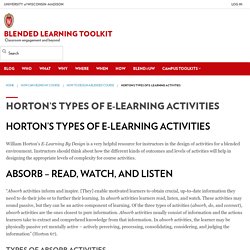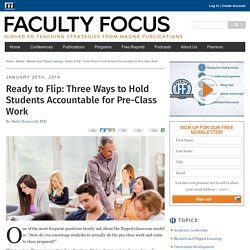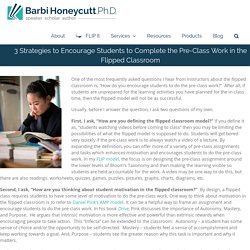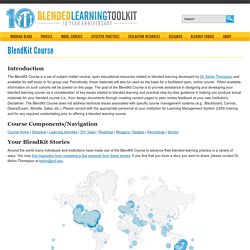

How We Use Social Media for Informal Learning. Vendors talk about social learning like its something revolutionary, but I’m here to tell you its not.

Informal learning is an everyday thing. Social media tools are just another platform we use to learn from each-other and find information serendipitously. For every sales pitch you hear about social learning, for every shiny social network logo you see out there on the web, you should be looking for real use cases and stories of social media being used in a real world setting… with tangible benefit to an organization. We’ve found our own niche in the social media solar system… and it takes our team 30ish minutes a week to fully participate. It’s become part of everyone’s work flow, widely accepted in our company culture, and a launchpad for each individual in our organization to find their own social media and informal learning sweet spot.
Blending Learning with Social Technology Components. HORTON’S TYPES OF E-LEARNING ACTIVITIES – Blended Learning Toolkit – UW–Madison. William Horton’s E-Learning By Design is a very helpful resource for instructors in the design of activities for a blended environment.

Instructors should think about how the different kinds of outcomes and levels of activities will help in designing the appropriate levels of complexity for course activities. “Absorb activities inform and inspire. [They] enable motivated learners to obtain crucial, up-to-date information they need to do their jobs or to further their learning. In absorb activities learners read, listen, and watch. These activities may sound passive, but they can be an active component of learning. Ready to Flip: Three Ways to Hold Students Accountable for Pre-Class Work - Faculty Focus. One of the most frequent questions faculty ask about the flipped classroom model is: “How do you encourage students to actually do the pre-class work and come to class prepared?”

This is not really a new question for educators. We’ve always assigned some type of homework, and there have always been students who do not come to class ready to learn. However, the flipped classroom conversation has launched this question straight to the top of the list of challenges faculty face when implementing this model in their classrooms. By design, the flipped model places more emphasis on the importance of homework or pre-class work to ensure that in-person class time is effective, allowing the instructor and the students to explore higher levels of application and analysis together.
If students are unprepared, it leads to frustration, stress, and anxiety for everyone. First, let’s clarify what we mean by a “flipped” classroom. Many instructors use video in their flipped classrooms. 3 Strategies to Encourage Students to Complete the Pre-Class Work in the Flipped Classroom - Barbi Honeycutt, Ph.D. One of the most frequently asked questions I hear from instructors about the flipped classroom is, “How do you encourage students to do the pre-class work?”

After all, if students are unprepared for the learning activities you have planned for the in-class time, then the flipped model will not be as successful. Usually, before I answer the question, I ask two questions of my own. First, I ask, “How are you defining the flipped classroom model?” If you define it as, “students watching videos before coming to class” then you may be limiting the possibilities of what the flipped model is supposed to do.
Students will get bored very quickly if the pre-class work is to always watch a video of a lecture. Blending Learning. The 'flipped' classroomYou may be familiar with the notion of the 'flipped classroom', a buzz term over the last couple of years, and mentioned at most conferences on digital learning.

The 'flipped classroom' is seen as a form of blended learning. What are the qualities of the flipped classroom, as these are described in the two videos here? Do these notions map onto notions of 'flexible learning' in any way? We'll discuss the 'flipped classroom' more in Part 2 of this course.
Please post any initial thoughts you have on the flipped classroom to the discussion area. Blended Learning Universe. BlendKit Course. Introduction The BlendKit Course is a set of subject matter neutral, open educational resources related to blended learning developed by Dr.

Kelvin Thompson and available for self-study or for group use. Periodically, these materials will also be used as the basis for a facilitated open, online course. The goal of the BlendKit Course is to provide assistance in designing and developing your blended learning course via a consideration of key issues related to blended learning and practical step-by-step guidance in helping you produce actual materials for your blended course (i.e., from design documents through creating content pages to peer review feedback at your own institution). Disclaimer: The BlendKit Course does not address technical issues associated with specific course management systems (e.g., Blackboard, Canvas, Desire2Learn, Moodle, Sakai, etc.).
Course Components/Navigation Your BlendKit Stories Download Map of BlendKit Course Materials During 2015 BlendKit2017 Enroll Now. Blending Learning in a Digital Age: Log in to the site.